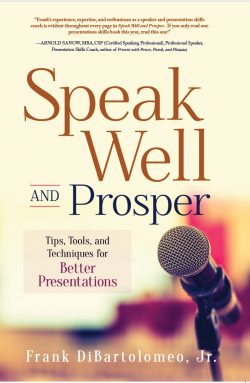Sunday, October 9, 2022

“Speak clearly, if you speak at all; carve every word before you let it fall.”
– Oliver Wendell Holmes
On November 19, 1863, President Abraham Lincoln delivered what became known as the Gettysburg Address (272 words, two minutes long) at the dedication of the Soldier’s National Cemetery in Gettysburg, Pennsylvania. However, many may not know that the principal speaker was Edward Everett, not President Lincoln.
Edward Everett’s speech which preceded President Lincoln’s remarks, was two hours long. At the end of President Lincoln’s Gettysburg Address, Mr. Everett told Mr. Lincoln this: “I should be glad if I came as near to the central idea of the occasion in two hours as you did in two minutes.”
Below is what I think you can learn as a speaker from this comparison of speeches at the dedication of the Soldier’s National Cemetery in Gettysburg, Pennsylvania, on November 19, 1863.
Less is More
When you have a long presentation, you tend to emphasize almost everything. But you have to remember audience members come to hear you present with various attention levels. Some audience members will be “hanging on your every word.” Some will be mildly interested in your subject. Some you will have to convince attending your presentation is a good use of their time.
“Whittling down” what you have to say in your presentation is hard work. Winston Churchill, the World War II prime minister of Great Britain, once said, “If you want me to speak for two minutes, it will take me three weeks of preparation. If you want me to speak for thirty minutes, it will take me a week to prepare. If you want me to speak for an hour, I am ready now.”
It takes a good bit of preparation for you to develop your presentations. It also takes a lot of effort to decide what to take out of your presentations.
The Accademia Gallery of Florence houses Michelangelo’s famous statue of The David. This is one of the finest sculptures in the world. It is important to note that The David started as one big block of Italian marble. When asked how he fashioned the exquisite statue, Michelangelo responded, “I just carved away everything that was not The David.”
Your job as a speaker is to “carve away” everything in your presentation that does not add to your message. This sounds simple, but it takes your thoughts and time to do this.
Through the Gettysburg Address, you can readily see the significant advantage of shortening your presentation to the bare minimum to get your message across to your audience.
The probability of wandering in your presentation is proportional to the length of your presentation: the longer your presentation, the greater chance you will wander.
Presentation Wandering
What do we mean by presentation wandering? Presentation wandering is when you go off message in your presentation. This takes up valuable time, confuses your audience, and confuses you.
This rarely happens in your shorter presentations because there is just no time for it. However, in your longer presentations, especially when your time limit is ambiguous, you have plenty of time to wander.
You may find yourself ad-libbing and going into areas you had no intention of doing. This often happens when you are nervous and feel you just have to keep talking.
I would never say to script out your whole presentation. However, I would never say plan out every last detail of your presentation because this stifles your creativity.
The German military strategist Helmuth von Moltke once said, “No battle plan survives contact with the enemy. Certainly, your audience is not your enemy, but you will have to modify your presentation plan “on the fly” once you encounter your audience. Therefore, even though your presentation plan will have to be modified during your presentation, the act of presentation planning during your practice is always a good thing to do.
You should plan your presentation with options you might have to invoke depending on your audience’s reaction. Then, just have backup plans in case something in your plan needs to change.
So, there are advantages to shortening your presentation to the bare minimum to get your message across to your audience and avoiding wandering during your presentation.
It is also best to say what you came to say and sit down.
Say What You Have to Say and Sit Down
Have you ever fallen in love with the sound of your voice when you deliver a presentation? Your audience is reacting enthusiastically to your presentation. You feel like an oracle, a person with all the answers. If you don’t watch yourself, you will keep talking and talking and talking. You have fallen “head over heels” in love with your voice.
How do you avoid falling in love with your voice? The first thing you have to do is realize it is happening. Then, purposely “ease on the brakes” of your presentation when you have made your points. Take out some supporting content with still conveying your message. Then summarize and sit down.
A bit of humility is also in order here. This comes with experience. Generally, experienced speakers know how to convey their message and when to end their presentations. This being said, the pride of even the most experienced speakers sometimes gets the better of them, and they drone on.
Another way to solve this problem is to plan to speak for only four minutes for every five minutes of your allotted time. You need the extra time for audience reactions to you and your responses to your audience.
Estimate when you are practicing your presentation and what elapsed time you are delivering your main points. If possible, have a timer on your cell phone where you can see it and stick to your elapsed time estimates for your main points you established while practicing.
So, to enhance your chances of a successful presentation, shorten your presentation to the bare minimum to get your message across, avoid wandering during your presentation, and say what you came to say and sit down.
When in doubt, take it out
Call to Action
After you have made each of your main points, move on
Don’t fall in love with the sound of your voice
To account for audience reactions and your response to your audience, plan your presentation only to cover four minutes of every five minutes allotted for your presentation.
“Expect the best. Prepare for the worst. Capitalize on what comes.”
– Zig Ziglar
_____________________________ Frank DiBartolomeo is a retired U.S. Air Force Lieutenant Colonel and award-winning speaker, presentation and interview skills coach, and Professional Member of the National Speakers Association. He was awarded Toastmasters International’s highest individual award, Distinguished Toastmaster because of his outstanding work in public speaking and leadership.
Frank formed DiBartolomeo Consulting International (DCI), LLC (www.speakleadandsucceed.com) in 2007. The mission of DCI is to help technical professionals to inspire, motivate, and influence their colleagues and other technical professionals through improving their presentation skills, communication, and personal presence. Reach Frank at frank@speakleadandsucceed.com and (703) 509-4424.
_____________________________ Don’t miss Frank DiBartolomeo’s latest book!
“Speak Well and Prosper: Tips, Tools, and Techniques for Better Presentations”

Available now at Amazon.com and BarnesandNoble.com